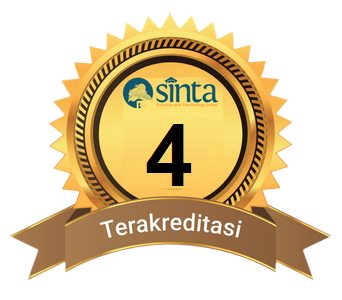ANALISIS KRITIS PEMIKIRAN TOKOH POLITIK DUNIA DALAM MENGEMBANGKAN HIGH ORDER THINKING SKILL MAHASISWA
Keywords:
Pemikiran Politik, Youtube, High Order Thinking Skill, MahasiswaAbstract
Riset ini meneliti tentang optimalisasi peran media sosial youtube dalam mengembangkan High Order Thinking Skill (HOTS) mahahasiswa pada mata kuliah filsafat politik. Pengembangan cara berpikir tingkat tinggi dilakukan melalui kegiatan analisis kritis pemikiran tokoh politik dunia yang dituangkan ke dalam bentuk video serta dikanalisasi secara terstruktur. Mata kuliah filsafat politik yang mengandung substansi pemikiran-pemikiran politik dunia dari yang pada umumnya dianggap sulit diubah menjadi lebih menyenangkan melalui strategi satu mahasiswa satu tokoh. Indikator keberhasilan pengembangan high order thinking skill mahasiswa dibuktikan melalui presentasi pemikiran tokoh serta relevansinya dengan kondisi saat ini secara lisan tanpa bantuan media apapun. Beberapa bagian penting dalam riset ini, pertama bahwa kanalisasi video pemikiran tokoh politik dunia menjadi wahana bagi mahasiswa untuk mendalami pemikiran tokoh yang diinginkan. Kedua, dengan adanya fokus mahasiswa membahas pemikiran salah satu tokoh menjadikannya ahli serta ketiga, metode pembelajaran yang diterapkan memberikan dampak yang lebih luas dan berkesinambungan.
This research examines the optimization of the role of social media YouTube in developing students' High Order Thinking Skills (HOTS) in political philosophy courses. The development of high-level thinking is carried out through critical analysis of the thoughts of world political figures which are poured into videos and channelized in a structured manner. Political philosophy courses that contain the substance of world political thoughts, which are generally considered difficult to change, become more enjoyable through the one student one figure strategy. Indicators of success in developing students' high order thinking skills are proven through verbal presentations of figures' thoughts and their relevance to current conditions without the aid of any media. Several important parts of this research are, first, that the video channelization of the thoughts of world political figures becomes a vehicle for students to explore the thoughts of the desired figures. Second, with the focus of students discussing the thoughts of one of the figures making him an expert and third, the learning methods applied have a wider and more sustainable impact.
Downloads
References
Ali, Z. S., & Yang, X. (2022). The Impact of YouTube Pandemic Advertising on People’s Attitudes Towards COVID-19. Online Journal of Communication and Media Technologies, 12(3), e202214.
Anderson, L. W dan Krathwohl, D.R (Terjemahan: Prihantoro. A) (2010). Kerangka Landasan untuk Pembelajaran, Pengajaran, dan Asesmen Revisi Taksonomi. Yogyakarta: Pustaka Pelajar.
Brookhart, S. M., & Nitko, A. J. (2011). Educational assessment of students. Pearson Higher Ed.
Chinedu, C. C & Kamin, Y. (2015). Strategies for Improving Higher Order Thinking Skills in Teaching and Learning of Design and Technology Education. Journal of Technical Education and Training (JTET), Vol. 7 No. 2. ISSN 2229-8932.
Darmuki, A. (2020). Upaya meningkatkan kemampuan berbicara mahasiswa menggunakan media aplikasi Google Meet berbasis unggah tugas video di youtube pada masa pandemi Covid-19. Jurnal Educatio Fkip Unma, 6(2), 655-661.
Fahmi, R., & Ikbal, A. (2020). Faktor-Faktor Determinan Peningkatan Tanggung Jawab Warga Negara Melalui Aktualisasi Kebijakan. Pelita: Jurnal Penelitian dan Karya Ilmiah, 20(2), 102-116.
Ikbal, A. (2019). PENGEMBANGAN NILAI-NILAI KEBANGSAAN PADA PROGRAM ToT LEMHANNAS RI DALAM MENGATASI RADIKALISME: Studi Deskriptif Terhadap Alumni ToT Lemhannas RI Provinsi Jawa Barat (Doctoral dissertation, Universitas Pendidikan Indonesia).
Ikbala, A., & Darmawana, C. National Values Based Learning: A Strategy in Counteracting Radicalism in Schooling. Eti Setiawati, et al.(Eds.), 91.
Kolo, A., & Ikbal, A. (2022). Membina Karakter Aktivis Mahasiswa Melalui Mata Kuliah Pendidikan Kewarganegaraan. PINUS: Jurnal Penelitian Inovasi Pembelajaran, 8(1), 11-21.
Krathwohl, D. R. (2002). A revision of Bloom's taxonomy: An overview. Theory into practice, 41(4), 212-218.
Mary, E. (2020). Analisis Kesulitan Belajar Materi Filsafat Pendidikan Kristen Pada Mahasiswa Sekolah Tinggi Teologi. Jurnal Teologi Praktika, 1(1), 15-29.
McNally, B., Chipperfield, J., Dorsett, P., Del Fabbro, L., Frommolt, V., Goetz, S., ... & Rung, A. (2017). Flipped classroom experiences: student preferences and flip strategy in a higher education context. Higher Education, 73, 281-298.
Nasution, A. K. P. (2020). Integrasi media sosial dalam pembelajaran generasi z. Jurnal Teknologi Informasi Dan Pendidikan, 13(1), 80-86.
Neumann, M. M., & Herodotou, C. (2020). Evaluating YouTube videos for young children. Education and Information Technologies, 25, 4459-4475.
Pohl. (2000). Learning to think, thinking to learn. [Dikutip pada Kamis, 2 Februari 2023]. Sumber: www.purdue.edu/geri
Sembiring, J. A. (2021). Pemanfatan Media Sosial dalam Pembelajaran Di Masa Pandemi Covid-19. Jurnal Basicedu, 5(6), 5565-5572.
Sholekah, D. D., & Wahyuni, S. (2019). Pemanfaatan media sosial dalam proses pembelajaran di SMPN 1 Mojo Kediri. Indonesian Journal of Islamic Education Studies (IJIES), 2(1), 50-60.
Suryani, Nunuk. Ahmad Setiawan dan Aditin Putria. (2018). Media Pembelajaran Inovatif dan Pengembangannya. Bandung: Remaja Rosdakarya
Susanto, Ahmad. (2014). Teori Belajar dan Pembelajaran di Sekolah Dasar. Jakarta: Kencana Prenada Media Group
Susanto, A. (2011). Perkembangan Anak Usia Dini: pengantar dalam berbagai aspeknya. Jakarta: Kencana Prenada Media Group
Tohari, H., & Bachri, B. S. (2019). Pengaruh penggunaan youtube terhadap motivasi belajar dan hasil belajar mahasiswa. Kwangsan, 7(1), 286906.
Trilling, B., & Fadel, C. (2009). 21st century skills: Learning for life in our times. John Wiley & Sons.
Tutiasri, R. P., Laminto, N. K., & Nazri, K. (2020). Pemanfaatan youtube sebagai media pembelajaran bagi mahasiswa di tengah pandemi covid-19.
Wardiana, Uswah. (2004). Psikologi Umum. Jakarta: PT. Bina Ilmu
Wijaya, H., & Arismunandar, A. (2018). Pengembangan model pembelajaran kooperatif tipe stad berbasis media sosial. Jurnal Jaffray, 16(2), 175-196.
Wilson, Andrea. (2015). YouTube in the Classroom. A research paper submitted in conformity with the requirements for the degree of Master of Teaching Department of Curriculum, Teaching and Learning Ontario Institute for Studies in Education of the University of Toronto.
Yudha, J. R. P. A., & Sundari, S. (2021). Manfaat media pembelajaran youtube terhadap capaian kompetensi mahasiswa. Journal of Telenursing (JOTING), 3(2), 538-545.
Yuniani, A., Ardianty, D. I., & Rahmadani, W. A. (2019). Era revolusi industri 4.0: peran media sosial dalam proses pembelajaran fisika di SMA. GRAVITASI: Jurnal Pendidikan Fisika Dan Sains, 2(01), 18-24.
Downloads
Published
How to Cite
Issue
Section
License
Copyright (c) 2023 Asep Ikbal

This work is licensed under a Creative Commons Attribution-NonCommercial-ShareAlike 4.0 International License.




__.png)
















